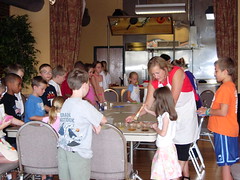(food) Deserts are complicated places
It's not that I deny that there are an inadequate number of places that sell fresh foods in Wards 7 and 8, as indicated in the recent survey by the Food Research and Action Center, and discussed in the Washington Business Journal article, "Food desert."
But the study fails to take into account how people shop for food, and the proximity of food sales establishments located just across the border in Maryland.
The United States is an unusual place. Most low-income people have access to a car within their broad social networks (see the chapter on "Use Value of Place" in Logan Molotch's Urban Fortunes) and do shop at supermarkets, often at stores not located within the city limits. (I base this on observations while living in the H Street neighborhood from about 1987 to 2005.) For example, many people shop at Shoppers Food Warehouse, which has many locations in Maryland, including just across the border from DC, but not one location within DC.
The point I am trying to make is that this is a far more complicated question than "merely" how many stores sell fresh food within a community. Perhaps the biggest problem is what people know or don't know about nutrition which of course influences how they consume food--whether they cook and what they cook, and/or the consumption of meals out-of-home. In all demographics more and more people consume more food out-of-home... not to mention practices in lower income households in DC. Maybe in 1990, I made a presentation at a set of home economics classes at Eastern High School and the teacher told me that her class was often the first place where students got practice eating a "family meal."
Not to mention how much media is consumed within the demographic that the FRAC study is considering, and what this media (primiarly television) communicates about nutrition and the dominance of particular companies within that media universe such as McDonald's. For example, studies find a direct relationship between obesity and how much television programming is consumed. Most television advertising on food is by processed food manufacturing companies and restaurant chains. There isn't that much advertising on the part of fruit and vegetable growers, promoting eating un- or under-processed fruits and vegetables.
A key component of my idea of "HealthyDC" stores is nutrition education and teaching people (including people like me) how to cook. And I think there need to be demonstration kitchens at Eastern Market and Florida Market, in part to teach nutrition education.

Teaching Kitchen, River Market, Little Rock, Arkansas. Photo: Daman Hoffman.
(Full disclosure. Many years ago I worked for the Center for Science in the Public Interest, a health and nutrition advocacy group, and my ex-wife worked for FRAC.)
Labels: food-agriculture-markets, health and wellness planning, public health



1 Comments:
Thanks for the great giveaway.
Post a Comment
<< Home